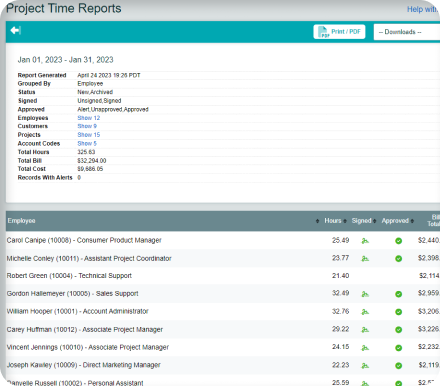Key Takeaways
- Discover easy time tracking software and best practices for freelancers.
- Learn how to accurately track hours worked for each project and client.
- Maximize your productivity with effective time management strategies.
- Utilize time tracking data to optimize your workflow and identify areas for improvement.
- Leverage time tracking to secure more freelance gigs and establish trust with clients.
Making Strides with a Time Tracking App
Choose the Right Tool
Look for a time tracking tool that aligns with your workflow and offers the functionality you require, whether it’s automatic time tracking, project management integration, or mobile compatibility. Tracking apps for freelancers come in many shapes and sizes.
Other apps will offer different functions, so don’t be afraid to test out multiple options until you find the perfect fit. Set up a free trial with Timesheets.com or utilize a free time tracking app like Clockify. Toggl Track also offers reputable tracking software for freelancers.
Create Detailed Task Descriptions
When tracking your time, it’s essential to provide clear and detailed task descriptions. Instead of generic labels like “research” or “design,” be specific about what you’re working on.
Detailed descriptions not only help you stay organized but also provide transparency for your clients and make invoicing a breeze.
Use Time Blocking Techniques
Time blocking is a powerful technique that involves allocating specific time slots for different tasks or projects. Start by identifying your most important tasks and allocating dedicated time blocks for each one.
Be sure to include breaks and buffer time for unexpected tasks or emergencies. Time blocking helps you stay on track and ensures accurate time tracked.
Track Time in Real-Time
One of the most common mistakes freelancers make with time tracking apps is waiting until the end of the day or week to log their hours. To avoid this pitfall, make it a habit to track your time in real-time. Start your timer as soon as you begin working on a task and stop it when you’re finished.
This real-time tracking ensures precision and saves you the headache of trying to recall your hours later.
Utilize Idle Detection and Reminders
Reminders can often be set to prompt you to start or stop your timer based on your schedule.
Mastering the art of time tracking takes practice and dedication, but accurate time tracking is the foundation of a successful freelance business. So, embrace these strategies, track your time like a pro, and watch your freelance career soar to new heights!

Leveraging Time Tracking Data to Secure More Freelance Gigs
As a freelancer, your detailed timesheets are a powerful tool that can help you secure more freelance gigs and grow your business. By leveraging the insights gained from your time tracking efforts, you can demonstrate your value, expertise, and reliability to potential clients.
Showcase Your Productivity and Efficiency

Your time tracking data provides concrete evidence of your productivity and efficiency. By analyzing your data, you can identify your average completion times for specific tasks or projects, allowing you to provide accurate estimates to potential clients.
Showcase your ability to deliver high-quality work within tight deadlines and highlight your track record of meeting or exceeding client expectations.
Highlight Your Expertise and Specialization
Time tracking data can also help you showcase your expertise and specialization in specific areas. By categorizing your tracked time by project type, industry, or skill set, you can identify patterns and trends in your work.
Use this information to position yourself as an expert in your niche and target clients who align with your strengths.
Create Compelling Case Studies and Testimonials
Your time tracking data provides a wealth of information that can be used to create compelling case studies and testimonials. By combining your tracked time with project outcomes and client feedback, you can paint a picture of your value and impact.
Highlight specific projects where your time management skills and expertise led to successful outcomes, such as increased efficiency, cost savings, or improved customer satisfaction.

Optimize Your Pricing Strategy
Time tracking data can also help you optimize your pricing strategy and ensure that you’re charging fair rates for your services. By analyzing your tracked time across different projects and clients, you can identify patterns in your workload and determine the average time required for specific tasks.
Use this information to set competitive yet profitable rates that reflect your expertise and the value you bring to the table.
Identify Opportunities for Upselling and Cross-Selling

Your time tracking data can reveal opportunities for upselling and cross-selling your services to existing clients. By analyzing the projects you’ve worked on and the skills you’ve utilized, you can identify additional areas where you can provide value to your clients.
By proactively presenting these opportunities to your clients, you can expand your business and secure more freelance gigs.
Continuously Refine Your Marketing and Outreach
Leveraging your time tracking data is an ongoing process. As you accumulate more data over time, regularly review and analyze it to refine your marketing and outreach strategies.
Identify the types of projects and clients that align with your freelance work and your strengths and focus your efforts on attracting more of those opportunities. Use your data to create targeted marketing materials, update your portfolio, and refine your pitch to potential clients.
Remember, your time tracking data is a valuable asset that can help you showcase your value, expertise, and reliability to potential clients. Start using your time tracking data to its full potential, and watch your freelance business thrive!

Effortless Time Management
Get Started with a Free Trial!
Integrating Time Tracking with Project Management
Centralized Data and Single Source of Truth
Integrating time tracking with project management platforms like Trello, Asana, or Basecamp allows you to have a centralized repository for all your project-related data. Instead of switching between multiple tools or spreadsheets, you can access your tasks, deadlines, and time entries in one convenient location.
This centralization eliminates data silos, reduces manual entry errors, and provides a single source of truth for your project information.
Accurate Time Allocation and Budgeting
Integrating time tracking with project management allows you to accurately allocate time to specific tasks, projects, and clients. By associating time entries with corresponding tasks or projects, you can gain a clear picture of how much time you’re spending on each aspect of your work.
This granular time allocation helps you identify areas where you may be over or underestimating your efforts, enabling you to make data-driven adjustments to your project timelines and budgets.
When time tracking is integrated with project management, it fosters enhanced collaboration and communication among team members. By sharing time tracking data within your project management platform, you can provide visibility into each team member’s progress and workload.
This transparency promotes accountability, identifies potential roadblocks, and facilitates proactive problem-solving.

Streamlined Invoicing and Billing
Integrating time tracking with project management streamlines the invoicing and billing process for freelancers. With time entries automatically linked to specific projects or clients, you can easily create invoices based on actual time spent.
Many time tracking tools offer built-in invoicing features or integrate with popular invoicing platforms, allowing you to create and send professional invoices directly from your project management system.
Choosing the Right Tools for Integration
To successfully integrate time tracking with project management, it’s crucial to choose tools that offer seamless integration capabilities. Look for time tracking software that provides native integrations or robust APIs that allow for smooth data synchronization with your preferred project management platform.
When evaluating tools, consider factors such as data security, user experience, and the level of customization and reporting features available.
Implementing and Refining Your Integration
Integrating time tracking with project management requires careful planning and implementation. Start by clearly defining your workflow processes and identifying the key data points you want to track and sync between the two systems.
Set up the necessary integrations and test them thoroughly to ensure data accuracy and reliability. Provide training and guidance to your team members on how to use the integrated system effectively, emphasizing the importance of task management.

As you implement the integration, continuously monitor and refine your processes based on feedback and data insights. Regularly review your time tracking and project management reports to identify areas for optimization and improvement. Be open to adjusting your workflow and adapting your tools as your business evolves and new requirements emerge.
By integrating time tracking with project management, freelancers can unlock a new level of efficiency, productivity, and business intelligence. This powerful combination streamlines workflows, enhances collaboration, and provides valuable insights for informed decision-making.
Unlock Productivity
Begin Your Free Trial Now!

Communicating Time Tracking to Clients
Include Time Tracking in Your Contract
Clearly outline to clients how you track your time, what tools you use, and how you will report your hours to the client. Specify any billable and non-billable hours, minimum time increments, and any other relevant details.
By addressing time tracking upfront in your contract, you establish a clear understanding and agreement with your client from the outset.
Explain the Benefits of Time Tracking
When communicating time tracking to clients, it’s important to highlight the benefits it brings to the project and the client-freelancer relationship.
Emphasize how accurate time tracking ensures transparency, allows for better project management, and helps you deliver high-quality work within the agreed-upon timeframe and budget.
Explain how time tracking data can provide valuable insights into productivity patterns, identify potential roadblocks, and facilitate data-driven decision-making.
Provide Regular Time Reports

To keep clients informed and engaged with your time tracking process, provide them with regular time reports. These reports should break down your hours by task, project, or date, giving clients a clear and detailed overview of how you’ve spent your time.
Use your time tracking tool to generate professional and visually appealing reports that are easy to understand and interpret. Share these reports on a weekly or monthly basis, depending on the project’s duration and the client’s preferences.
Be Open to Client Questions and Feedback
Encourage open communication with your clients regarding time tracking. Make it clear that you welcome any questions, concerns, or feedback they may have about your tracking process or the time reports you provide.
Be prepared to explain your methodology, clarify any ambiguities, and address any issues that may arise.
Educate Clients on Time Tracking Best Practices
Share relevant articles, case studies, or personal anecdotes that illustrate the benefits of accurate time tracking. Offer guidance on how clients can effectively review and interpret your time reports and encourage them to provide feedback or ask questions.
By empowering clients with knowledge and understanding, you foster a more collaborative and productive partnership.
Address Client Concerns with Empathy
Some clients may still have concerns or objections. Approach these situations with empathy and understanding, acknowledging the client’s perspective and addressing their concerns head-on.
Listen actively to their feedback and be willing to make adjustments or provide further explanations as needed. If a client raises issues with specific time entries or questions your tracking accuracy, respond calmly and professionally, providing evidence and context to support your records.
Continuously Refine Your Communication Strategy
Communicating time tracking to clients is an ongoing process that requires continuous refinement and adaptation. As you work with different clients and projects, pay attention to what communication strategies work well and where there may be room for improvement.
Seek feedback from clients on your time tracking reports and communication style and be open to making adjustments based on their input. Stay updated on industry best practices and emerging trends in time tracking communication and incorporate new techniques and tools as appropriate.

Remember, clear and effective communication is the key to building strong, long-lasting client relationships. By proactively communicating your time tracking practices, providing regular reports, and addressing client concerns with empathy and professionalism, you lay the foundation for a transparent and trusting partnership.
Embrace open communication and continuously refine your approach to ensure that time tracking becomes a seamless and integral part of your freelance collaborations.
Conclusion
However, by implementing the strategies and techniques outlined here, you can take control of your time, streamline your workflow, and unlock the door to a thriving freelance career. If you’re working with startups or small businesses, implementing an effective startup time off management strategy can also be beneficial.
As you embark on your freelance journey, remember that time off management requires continuous refinement and adaptation. Stay open to learning and look for new tools and techniques that can help you optimize your workflow and grow your business.







